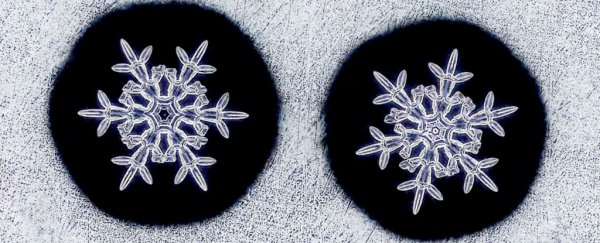It's one of those things we all get told as children: that every snowflake is a uniquely beautiful thing, as there are no two snowflakes alike.
But is that actually true? Well… kinda yes and kinda no. As the video from Deep Look explains below, the random mishmash of environmental conditions that combine to form individual snowflakes end up ensuring that each ice crystal is effectively one of a kind.
But if those conditions can be somehow controlled… snowflake uniqueness isn't necessarily guaranteed.
To understand how snowflakes came to be understood to be unique, it's helpful to examine where they come from in the first place.
Snowflakes form in clouds in the atmosphere, when water vapour cools, and individual water molecules begin to stick to one another in frigid air, often starting around a particle in the air, like a piece of dust.
When they do this, they assemble in a hexagon shape, due to bonds being made between the hydrogen and oxygen atoms of each H2O molecule.
As more water molecules attach to this hexagonal structure, the snowflake grows outwards in six directions due to the primary hexagon – but apart from that common theme, almost infinitely subtle variations in humidity and temperature mean that these six branching arms of a snowflake each develop in their own way.
At least, that's what happens when snowflakes form in the random and uncontrolled conditions of Earth's atmosphere. As for the highly controlled conditions of the laboratory environment, it's a somewhat different story.
Caltech physicist Ken Libbrecht is something of a snowflake guru, and has been studying for decades how these intensely intricate formations take shape.
As the Deep Look video shows, by using a specialised atmospheric chamber in his lab, Libbrecht can make and effectively 'design' his own snowflakes, adjusting humidity and temperature to manipulate the way that the tiny ice crystals grow.
"After a little practice you can make things that are faceted or branched on demand," he told Joshua Cassidy at KQED Science.
"I can make nice plates or turn the knob and make some branches or make side branches. You can kind of design snow crystals."
Not only that, but by exposing two 'seed crystals' – the name for the primary, starter hexagon – to the exact same controlled conditions, you can effectively create twin snowflakes, which exhibit the same intricate patterns.
In other words, in the right circumstances, snowflakes aren't guaranteed to be unique, and yep, some two are indeed alike. Sorry, kids. In fact, sorry, everybody.
"I like to call them identical twin snowflakes because, like identical twin people, they're not absolutely exactly the same but they're very, very similar," says Libbrecht.
Of course, the only snowflakes most of us ever encounter and care about are the natural ones that form in the sky – not artificial ice crystals grown in the lab.
So is it possible that snowflakes forming in the atmosphere could also be twins, or are natural snowflakes destined to never be alike like we were always told?
We'll let the video explain that one – but just remember, even if snowflakes aren't actually one of a kind, that doesn't make them any less beautiful.
That is, unless you look at them super, super close.
